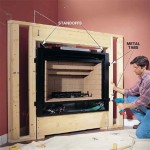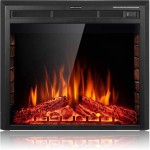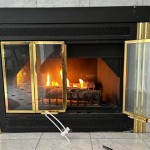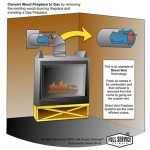Painting a Fireplace White: A Comprehensive Guide
A fireplace often serves as a focal point in a room, drawing attention and contributing significantly to the overall aesthetic. Older fireplaces, however, may sport designs or materials that clash with contemporary styles. Painting a fireplace white offers a simple yet effective method to modernize its appearance, creating a brighter and more versatile centerpiece. This article provides a comprehensive guide to painting a fireplace white successfully, covering essential preparation, material selection, painting techniques, and post-painting care.
Key Point 1: Preparation is Paramount
Proper preparation is the cornerstone of any successful painting project, and it is especially crucial when dealing with fireplaces due to the potential for soot, creosote, and other residues that can interfere with paint adhesion. The preparation process involves cleaning, repairing, and priming the fireplace surface.
Cleaning the Fireplace: Before commencing any other preparation steps, a thorough cleaning is essential. Using a stiff brush and a vacuum cleaner, remove loose debris, dust, and soot from all surfaces of the fireplace, including the firebox, hearth, mantel, and surrounding areas. For more stubborn stains and residues, a specialized fireplace cleaner or a solution of trisodium phosphate (TSP) can be used. Always follow the manufacturer’s instructions for the cleaning product being used and wear appropriate protective gear, such as gloves and eye protection. Thorough rinsing with clean water is necessary to remove any remaining cleaner residue. Allow the fireplace to dry completely before proceeding to the next step.
Repairing Damage: Inspect the fireplace for any cracks, chips, or other damage. Small cracks in brick or stone can be filled with a masonry crack filler. Larger cracks may require patching with mortar. Repair any damaged grout between tiles with a suitable grout repair compound. Ensure that all repairs are completely dry and cured according to the manufacturer’s instructions before painting. Failure to address these issues will result in an uneven and potentially unstable painted surface.
Priming the Surface: Priming is a critical step in ensuring proper paint adhesion and preventing stains from bleeding through the final coat of paint. Choose a primer specifically formulated for the fireplace material, whether it is brick, stone, or metal. For porous surfaces like brick or stone, a masonry or concrete primer is recommended. For metal surfaces, a rust-inhibiting primer is essential. Apply the primer evenly, following the manufacturer's instructions regarding application techniques and drying times. Multiple coats of primer may be necessary to adequately seal the surface and create a uniform base for the paint.
Key Point 2: Selecting the Right Materials
Using the appropriate materials is crucial for achieving a durable and aesthetically pleasing finish. The choice of paint, primer, and brushes will directly impact the final outcome and the longevity of the painted surface.
Choosing the Right Paint: The type of paint selected should be suitable for the material of the fireplace and the conditions it will be exposed to. For brick and stone fireplaces, a masonry paint or a high-quality latex paint with a masonry primer is recommended. Masonry paints are specifically formulated to withstand the alkaline conditions of concrete and brick and are breathable, allowing moisture to escape. For metal fireplaces, a heat-resistant paint is necessary, particularly for surfaces directly exposed to heat within the firebox. High-heat paints are available in spray cans and are designed to withstand temperatures up to 1200°F. Opt for a paint with a matte or eggshell finish to minimize glare and create a more subtle look. Glossy paints can highlight imperfections and create an overly reflective surface that may not be desirable.
Selecting the Correct Primer: As mentioned in the preparation section, the primer should be specifically chosen based on the material of the fireplace. A masonry primer is essential for brick and stone, while a rust-inhibiting primer is crucial for metal surfaces. The primer should be compatible with the paint selected to ensure proper adhesion and prevent any adverse reactions. Review the manufacturer's recommendations for compatible primers and paints to avoid any potential issues.
Choosing the Appropriate Application Tools: The choice of brushes and rollers can significantly impact the quality of the final finish. For textured surfaces like brick or stone, a brush with stiff bristles is recommended to effectively work the paint into the crevices and pores. A high-quality paintbrush will provide better coverage and a smoother finish compared to a cheaper brush that may shed bristles. For smooth surfaces like metal, a foam roller or a fine-bristle brush can be used to achieve a smooth and even application. Use painter's tape to mask off any areas that should not be painted, such as the surrounding wall or the firebox opening. A paint tray with a liner will make it easier to load the brush or roller with paint and prevent spills.
Key Point 3: Painting Techniques and Post-Painting Care
Applying the paint correctly and providing proper post-painting care will ensure a long-lasting and aesthetically pleasing finish. Proper application techniques will minimize drips, runs, and uneven coverage, while post-painting care will help maintain the appearance and durability of the painted surface.
Applying the Paint: Apply the paint in thin, even coats, allowing each coat to dry completely before applying the next. Avoid applying thick coats of paint, as this can lead to drips, runs, and cracking. For textured surfaces, use a stippling technique with the brush to work the paint into the crevices and pores. For smooth surfaces, use long, even strokes with a roller or brush. Overlap each stroke slightly to ensure complete coverage and avoid any gaps. Pay close attention to corners and edges, ensuring that they are fully covered. Depending on the color and opacity of the paint, two or three coats may be necessary to achieve the desired coverage and finish. Allow ample drying time between coats, following the manufacturer's recommendations.
Curing Time: Once the final coat of paint has been applied, allow the paint to cure completely before using the fireplace. Curing time refers to the period during which the paint hardens and fully adheres to the surface. The curing time will vary depending on the type of paint used, the temperature, and the humidity. Consult the paint manufacturer's instructions for recommended curing times. Avoid exposing the painted surface to heat or moisture during the curing process, as this can interfere with the curing process and weaken the paint's adhesion.
Post-Painting Maintenance: After the paint has fully cured, regular maintenance will help keep the fireplace looking its best. Clean the painted surface regularly with a damp cloth to remove dust and soot. Avoid using harsh chemicals or abrasive cleaners, as these can damage the paint finish. Inspect the painted surface periodically for any signs of damage, such as cracks, chips, or peeling paint. Repair any damage promptly to prevent it from spreading and causing further deterioration. If the paint becomes stained or discolored, it can be touched up with a fresh coat of paint. Over time, the painted surface may require a complete re-painting to refresh its appearance. Following these maintenance guidelines will help ensure that the painted fireplace remains a beautiful and functional centerpiece in the home for years to come.
In summary, painting a fireplace white requires careful planning, meticulous preparation, the selection of appropriate materials, and precise application techniques. By adhering to the guidelines outlined in this article, homeowners can transform their existing fireplaces into a stylish and contemporary focal point within their living space. The end result is a brighter, cleaner aesthetic that complements a wide range of interior design styles, ultimately enhancing the overall ambiance of the home.

Painting Brick Fireplace White A Renovation Story

20 Best White Painted Fireplace Ideas House Design Brick Paint

Painting Our Brick Fireplace White Emily A Clark

How To Paint A Brick Fireplace Young House Love

Lessons From A White Painted Fireplace Makeover The Inspired Room

How To Paint A Brick Fireplace

How To Paint Your Fireplace Brick Surround

Lessons From A White Painted Fireplace Makeover The Inspired Room

How To Paint A Brick Fireplace What Use Home With Janny

How To Paint A Brick Fireplace Beamin Moore
Related Posts








